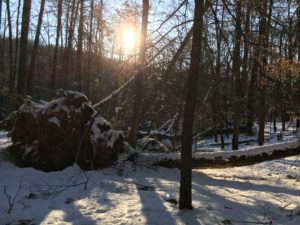 Hello fellow readers, If I may share a story about Mettler’s Woods located in Somerset, NJ.
Hello fellow readers, If I may share a story about Mettler’s Woods located in Somerset, NJ.
On the second day of Spring, we braced for another round of blinding snow and high winds. Instead, a peaceful eight inches of fluff fell. Good thing as we were all weary. The snow quickly melted as temperatures warmed. Spring is here at last! But the cleanup of fallen trees from our two nor’ easters seems overwhelming. I came across an article in AMC Outdoors (Sept/Oct 2017 issue) with comforting wisdom worthy of sharing.
About Mettler’s Woods, an old-growth forest
In the article, Bringing New Life to Old Growth, Lindsay Konkel talks about a 65-acre ancient forest in Somerset, NJ, called Mettler’s Woods, with old hardwood trees that “predate the Revolutionary war.” Old-growth woods are rare in the Northeast due to logging and farming by our early settlers.
Mettler’s Woods has a vast history. Growth rings on ancient fallen trees show cycles of fire every decade. Presumably, the Lenni-Lenape, who occupied the region until the 1700s, created the burns to open up sightlines for hunting and to promote understory growth. After that, Dutch settlers inhabited the land that was passed down for generations in the Mettler family. In the 1950s, core samples of oaks and beech that toppled in a hurricane showed some over 350 years old, which spiked the interest of a logging company to purchase the land. Instead, a committee of citizens and the United Brotherhood of Carpenters and Joiners bought the property and donated it to Rutgers University in 1955. It became officially named Hutcheson Memorial Forest.
Mettler’s Woods has declined dramatically
In recent years the ancient forest has declined dramatically. Trees have fallen in storms and from old age. Suburban sprawl has caused deer populations to explode, decimating saplings that would replace the aging trees. Plus, they’ve devastated native plants, allowing invasive species such as Japanese barberry, garlic mustard, privet, and multiflora rose to take over just as they have here.
Let nature run its course. Let trees lay where they fall.
One of the stipulations of the donation to Rutgers was the forest was to remain unmanaged. Let nature run its course. Let trees lay where they fall. The article mentions fallen trees leave gaps in the earth that serve as vernal pools providing critical habitat for amphibians – which makes me less sad over the dozen trees that tumbled in our woods, leaving massive roots thrice my height. It’s a natural process for trees to fall and decay, and they fertilize and prepare the soil for more trees to sprout in the newfound opening of light. Nature has a cycle, just as we do, just as the seasons of time. With endings come new beginnings and the hope for new life. So long nor’ easters. Happy Easter to all!
Garden Dilemmas? Askmarystone@gmail.com
Free tours of Hutchinson Memorial Forest are scheduled year-round on Sundays. Visit www.hmf.rutgers.edu to learn more.
This column is featured in Mary Stone’s Garden Dilemmas Podcast:
One of the native wildflowers to remain in Mettler’s Woods, and one of the first to show in Spring, are spring beauties (Claytonia virginica), which can endure grazing, deer are not big fans, and survive even if there are only a few trees surrounding them. They’re also edible and tasty for humans, but don’t eat the ones out in nature. You can buy corms (underground plant stems) and grow your own. Their clusters of star-like light pink or white flowers with tiny pink strips dance atop dark green grassy leaves in early Spring. The foliage remains after the bloom and grows to about a foot high before going dormant in late Spring.




